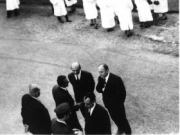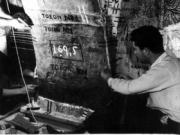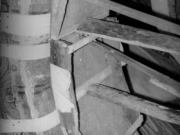The histroy of conservation at the BCM
The history of conservation at the BCM can be considered to have begun in 1915 when, just one year after its foundation, the Museum introduced conservation in a primitive form which would rapidly evolve after World War Two.
The BCM came to play a leading role in the conservation of paintings and mosaics, in particular, and gradually developed into an important centre for training in systematic conservation techniques.
- Key personnel and events
The first conservation workshop was set up on-site in 1930. Athanasios Vianginis (1929) and Fotis Kontoglou (1930) were charged with repairing the exhibits for the BCM’s first exhibition in the newly-renovated Villa Ilissia, former residence of the Duchesse of Plaisance.
The Museum continued to conserve its artefacts on a systematic basis after 1930, and the ranks of the artist-conservators employed by the Museum were swelled with the addition of Vasileios Rasevsky (1937), Manolis Noukakis (1943), Angela Ioannou (1944) and Fotis Zachariou (1951).
Greece’s first certified conservator, Tasos Margaritof, returned from Italy in 1958, followed by Stavros Baltogiannis in 1963 and Giannis Kolefas in 1965. Employed at the BCM, these conservators would preside over the changing perception of conservation as ‘repair’ to a more scientific approach.
The years that followed witnessed huge advances in the sphere of conservation and the introduction of new media and methods.
The setting up of the Central Conservation and Restoration Workshop (KES) in 1965 was another milestone in the history of conservation at the BCM. The workshop based at the BCM was called the “Central Workshop for the Conservation and Restoration of Paintings and Mosaics”; seeking inter alia to train young conservators, it would lead in time to the opening of the Museum’s Antiquities Conservators’ Training School. The teaching at the School, which was operational between 1969 and 1971, was undertaken by the Museum’s three ground-breaking conservators as well as by professors, archaeologists, chemists and others. The 120 young conservators who attended the School’s two-year course went on to work at the KES before working around Greece within the Archaeological Service. The KES’s considerable achievements are evident from its valuable archive, which is now held in the Museum.
There were three conservation workshops at the BCM during the Eighties and Nineties, but the pressing need to systemically conserve the BCM’s remaining collections saw these later expanded to five: the minor arts, textiles, wall paintings and canvases workshops in 1999 and the mosaic workshop in 2003.
Today, the Museum’s conservators are faced with the task of fully utilizing and building on the work bequeathed to them by their predecessors.














